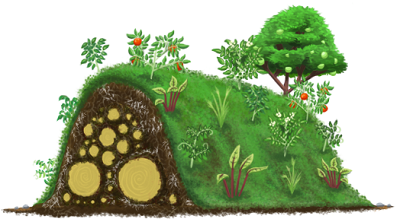How it Works
Hugelkultur is simple in theory, although labor intensive. In hugelkultur, woody material of various sizes/thicknesses is laid down into a bed-shaped pile on top of the soil, and then covered completely with dirt and planted as a raised bed. Usually the beds are stacked about 6 or 7 feet high, although they can be of any reasonable size. Greens are often added along with the wood to provide extra nutrients and nitrogen for the decomposition process. The covering of dirt speeds the decomposition of the wood, which when rotting becomes very sponge-like and holds a lot of water as well as producing heat. The rotting material also attracts large numbers of worms, which till and areate the pile and also aid in breaking down the material. As the material breaks down it settles and decreases in size until it is purely soil and much shorter than it started out. How long it takes the pile to decompose depends on the size of the wood used and on the climate, but varies from a few years to a decade.
What It Actually Does
In practice, hugelkultur is best suited for use in cold climates. If the tall piles are aligned well with the sun, they can collect heat very efficiently, and the rotting material provides additional heat from below to prevent roots from being frozen. Combined with other techniques this can significantly extend the growing season in places where the growing season is typically short.
In dry climates, the exposed piles tend to dry out very quickly compared to deep soil layers or ground water. In warm climates, wood chips mixed into the soil (but not so many that roots can't grow through) or sheet mulching both outperform hugelkulture and attract more worms and bugs. Large pieces of wood make it difficult for roots to grow through, and can actually perform worse than not doing anything at all. Combined with the large amount of labor required to construct hugelkultur piles, this makes hugelkultur an unattractive option in most circumstances.

No comments:
Post a Comment